At this year’s Railway Challenge award ceremony, its chief judge, Bill Reeve announced that, without doubt, this was the best challenge yet as the quality of entries and locomotive performance was the highest that the judges had seen. He advised that the judges considered it a privilege to work with the teams and learn of their clever ideas.
This report shows that it is hard to disagree with these comments. It also demonstrates how organising and running this complex challenge is a significant achievement that greatly benefits the industry by developing future engineers. The circa 20-strong team of judges and other volunteers from the Institution of Mechanical Engineers (IMechE) Railway Division deserve much credit for making the challenge happen.
Rules and specification
The Railway Challenge takes place on the 3km, 10 ¼ inch gauge Stapleford Miniature Railway on the Gretton Family estate near Melton Mowbray, operated by the Friends of the Stapleford Miniature Railway (FSMR). A Railway Division steering group directs the production of the competition’s rules and technical specification. Items covered by the rules include:
- Maximum team size is 15, with no more than 40% previously entering the challenge.
- Members must be over 18 and either a student, graduate of no more than two years, or an apprentice.
- Safety requirements including the need for method statements for defined hazardous activities.
- The method of scoring and application of penalties.
The technical specification gives the teams the flexibility to meet specified performance requirements. It requires them to produce a locomotive weighing no more than 2,000kg with an axle load not exceeding 500kg and have a maximum speed of 15km/hr. It must be able to operate for three hours without refuelling at a continuous 5km/hr up a 2% gradient with a 400kg trailing load.
Other requirements include:
- Fit within the Stapleford railway’s loading gauge.
- Ninety-five percent of locomotive, by mass, must be recyclable.
- Refuelling to 100% capacity within 120 seconds, this may include the replacement of energy storage assets.
- Operation under all forms of precipitation, at temperatures between -10 and +40 degrees centigrade and between 0 and 90% humidity levels.
- Operate on track with 20 metre radius minimum horizontal curvature, maximum twist gradient of 6 mm over 0.25 metres and maximum gradient of 1 in 84.
- A maximum braking rate of 1.3 m/s/s
- Warning lights and horn, remote control operation, functional status indications to be seen by both driver and judge.
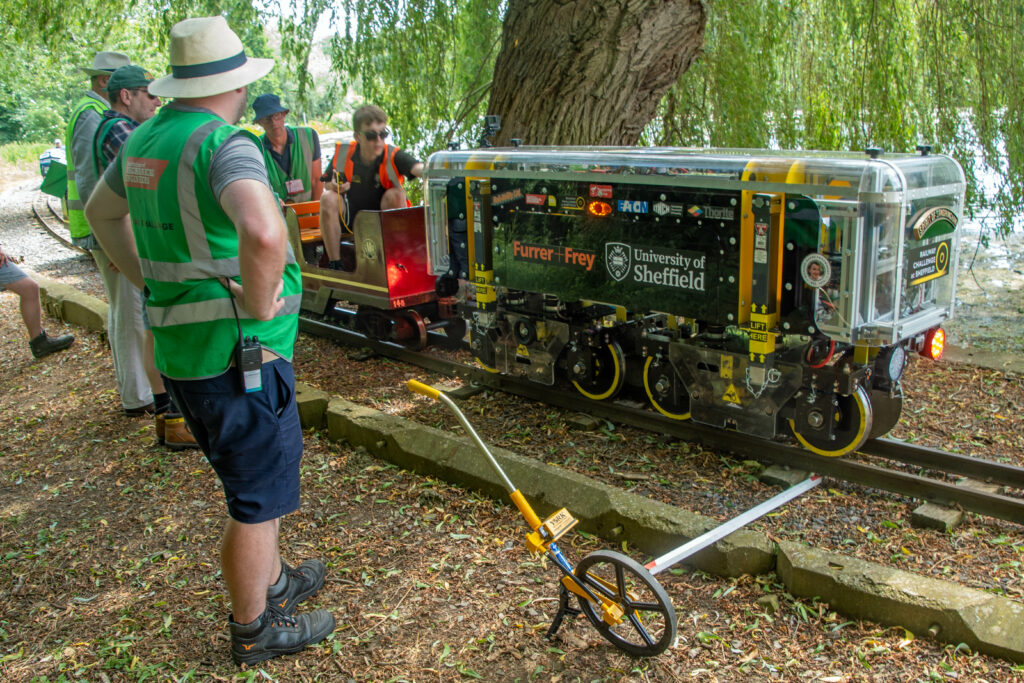
For the autostop challenge, an automatic braking mode must stop the train exactly 25 metres after passing a lineside marker. For the energy storage challenge, there needs to be a clear indication that the locomotive is being powered only by energy recovered from bringing the locomotive to a stand.
The specification also requires a comprehensive set of documents including: outline project plan; bill of materials; a top down and a bottom up safety analysis; business case presentation; a driver’s manual; innovation paper; method statements; detailed drawings including a control schematic; maintenance manuals; video of the locomotive under test; and a design report.
This design report must outline the locomotive’s design philosophy and contain a matrix demonstrating compliance with each of the specification’s clauses. Calculations demonstrating adequacy of the locomotive’s structure and safety of the vehicle’s suspension are also required. These need to consider curving wheel flange forces and show that maximum wheel unloading will not exceed 60% of normal load.
For the poster challenge, teams have also to supply an A0 poster summarising the locomotive’s system architecture and its functional principles.
Programme of events
Prior to the event, the teams must submit their design report, innovation paper, method statements and video of their locomotive testing, as well as delivering a virtual business case presentation. This requires teams to act as representatives of a company selling their locomotive to a large corporation and requires teams to show that their design meets the customer’s demands and can be profitably manufactured.
The Railway Challenge takes place over four days. On Thursday 22 June the teams were individually briefed and then unloaded their locomotives in accordance with their method statements. The teams also set up their campsites on the ground adjacent to the station. The IMechE staff, led by Fiona Wong, set up the marquee which was the administrative base and was used for briefings, the Friday night social evening, and the award ceremony.
On Friday, the first task was scrutineering led by the Railway Division’s Tim Poole whose team had a 33-point check list to confirm that locomotives were safe to run and built to the specification. To pass scrutineering, locomotives had to collect seven coloured stickers awarded for each scrutineering aspect. These were static tests of a physical inspection; documentation and calculations; indications; markings; user guide; and evidence of reliability. After static testing, locomotives were allowed to run on the railway for dynamic scrutineering.
Full set of scrutineering stickers
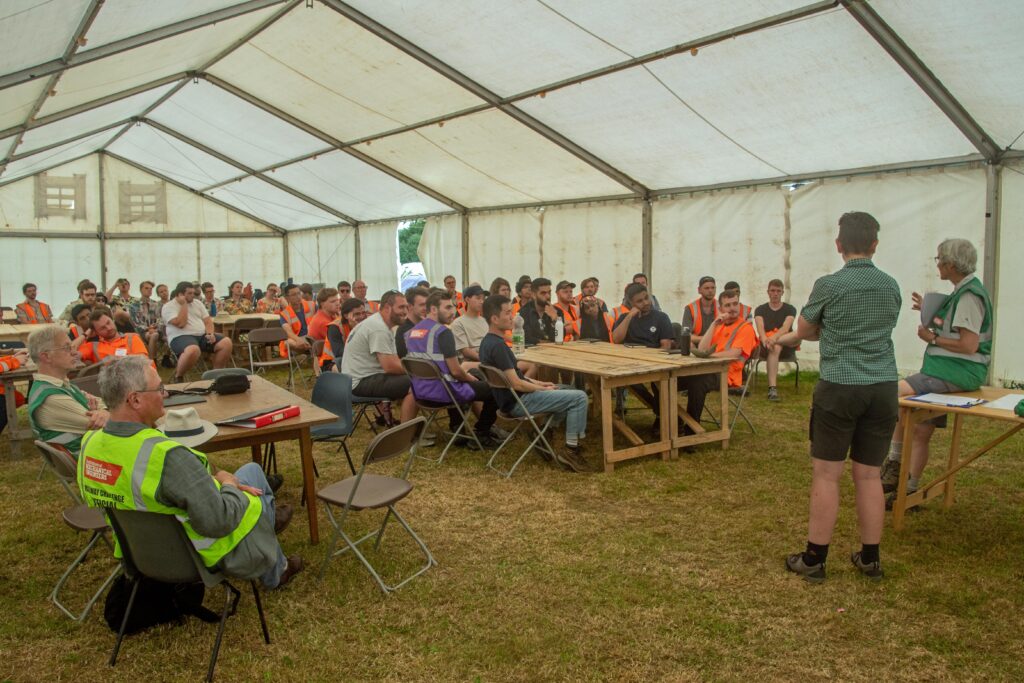
Friday also saw some refuelling and maintainability challenges. The latter required a powered wheelset to be removed and replaced in the fastest possible time. This was another potentially hazardous task requiring a method statement. To minimise the risk, this was also done in stages monitored by the judges. For example, prior to lowering the locomotive, the judges confirmed it was safe to do so.
Maintainability and refuelling challenges continued during the Saturday. One at a time, each team was also given the opportunity to give their locomotive a test run to try each of the dynamic challenges. The test often highlighted issues so some teams spent much of Saturday working on their locomotives.
Sunday was the day for the on-track dynamic challenges. It was also the day for spectators, for whom FSMR provided a steam hauled train. As described below, with up to four trains an hour, this had its operational challenges.
Sunday’s railway operations
Stapleford station has various sidings and a turnaround triangle. From the station, an 800-metre single line runs down a 1 in 80 gradient to a 1.2km balloon loop. During the weekend, each locomotive was planned to run around this loop three times (dynamic scrutineering, test run, and dynamic tests). On the Sunday, FSMR also provided spectator trains.
FSMR’s contribution is crucial to the success of the event. Led by Richard Coleby, it controls all train movements, provides a rescue locomotive, and a guard on each train. An important principle is all train movements are controlled by an FSMR controller who only accepts requests for movements from the Railway Challenge’s operational controller, Bridget Eickhoff. Her role includes changing the operational plan as required, for example in the event of a locomotive failing or not being ready in time.
On the Sunday, this plan enabled up to four trains an hour to be run. These were: the spectator train, the FSMR’s rescue locomotive, and up to two competitor’s test trains consisting of a team’s locomotive hauling two FSMR carriages for the driver, riding judge, and FSMR guard.
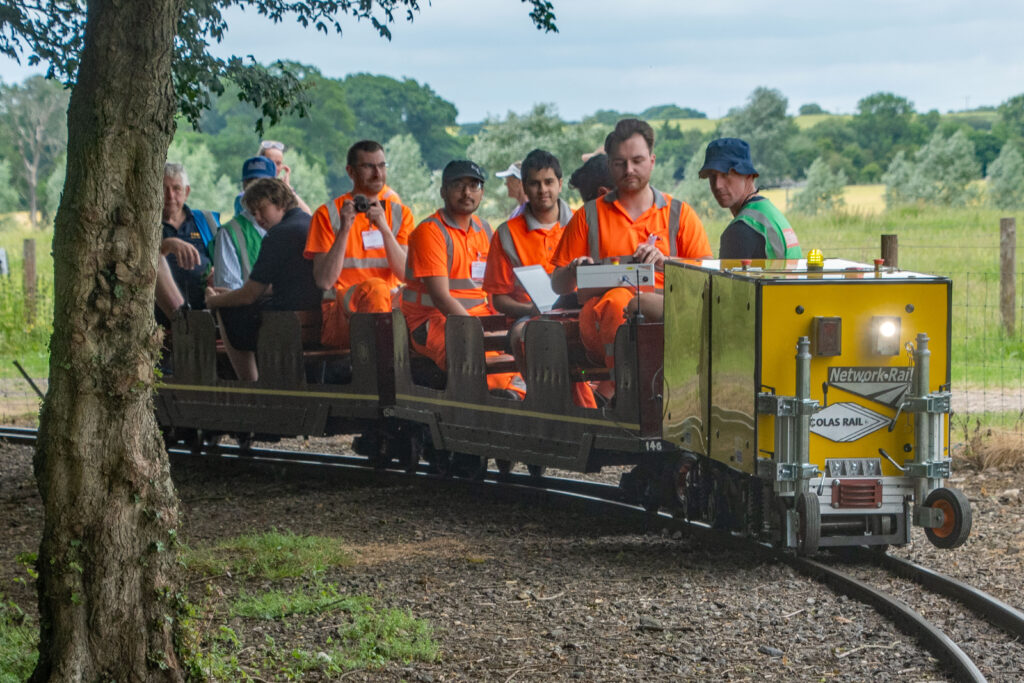

The first steam hauled spectator train left the station at 09:00, thereafter the plan was as follows:
- Spectator train stops briefly at the Haven, then goes around the balloon loop and halts at the signal before the points at the Haven.
- Test train 1 leaves the station to do the autostop challenge (A to B). It is followed by the rescue locomotive as it does its challenges.
- Test train 1 then does the ride comfort challenge. To do so it is fitted with an accelerometer (D) then goes around the loop to point E where the accelerometer is removed.
- Once the test train passes point D, the spectator train returns to the station.
- Test train 1 does the energy storage challenge (F).
- After the spectator train returns to the station, test train 2 does the autostop (A to B), ride comfort (D to E), and energy storage (F) challenges.
- Once test train 2 has passed point D, test train 1 moves to point G for its traction challenge and noise challenges (H to I), after which it returns to the station.
- Test train 2 does the traction and noise tests (H to I) and returns to the station.
This enables a maximum of 12 test trains to be run over a six-hour period during the challenge day and easily accommodated the seven operational test trains on the main challenge day. Yet a significant increase in entries would present a real-world problem of rail capacity management.
An evolving event
Rail Engineer has reported on the Railway Challenge since the first event in 2012 when four locomotives faced five challenges: traction; energy storage; ride comfort; business case; and design. This year the teams faced 12 challenges. Those additional to the 2012 event are: noise (2014); maintainability (2015); reliability (2016); innovation (2016); poster (2018); autostop (2019); and refuelling (2022).
There was also an energy efficiency challenge in 2015. However, precisely measuring energy consumption for the variety of traction at the event was not practicable and remains elusive.
The traction mix has changed significantly over the years. In 2012, three locomotives were powered by petrol generators, whilst the University of Birmingham fielded the UK’s first hydrogen locomotive. The 2017 challenge saw the first battery powered locomotive and nine locomotives were powered by generator sets. In 2022, only one locomotive was petrol powered and six were battery powered. This year, for the first time, there were no generator sets. The increasing use of battery traction was encouraged by a rule change allowing refuelling by changing batteries.
The maximum number of entries has been 11 locomotives on site, although the maximum number able to undertake the dynamic tests has been seven. The organising committee aims to attract many more entrants. However, although the Stapleford miniature railway is ideal for the Railway Challenge, its layout needs to be enhanced to realise this vision.

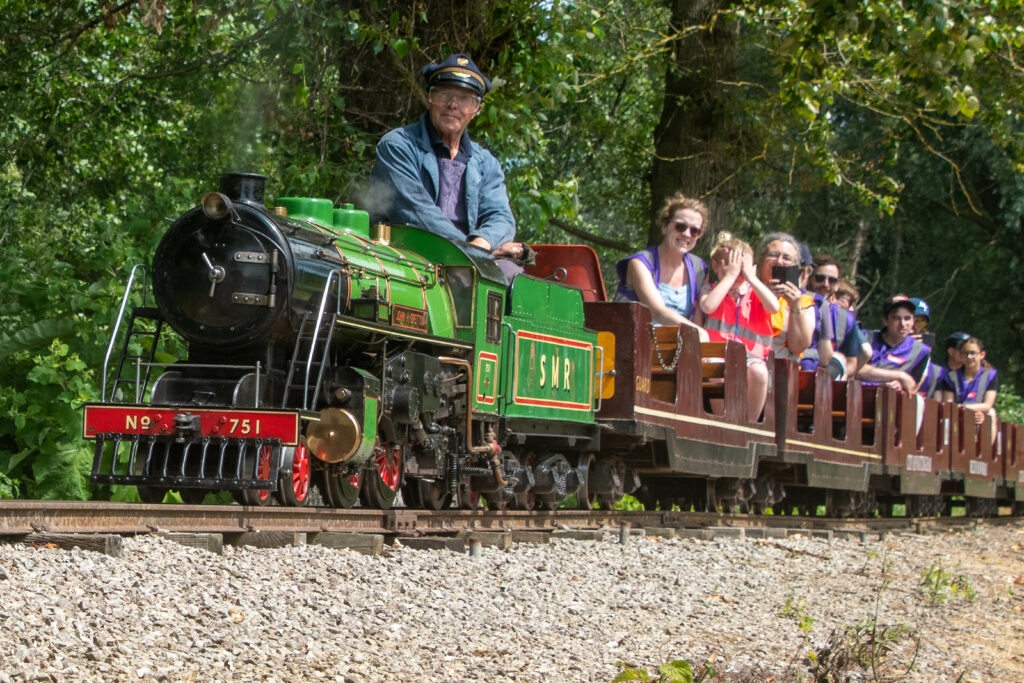
One such enhancement is a line from the station headshunt to a new turntable with 12 track spurs, and passive provision for another four. These will have hardstanding with each able to accommodate two locomotives and so will provide additional space for teams to work on their locomotives with the flexibility of despatching them in the required order. At the challenge weekend, work on this facility was seen to be well advanced. It is expected to be operational for next year’s Railway Challenge.
Professor Simon Iwnicki, who proposed the Railway Challenge in 2010 and has chaired the organising group ever since, explained that this work has been generously supported by Network Rail which surveyed the site and designed the turntable, as well as donating ballast. FSMR has also actively supported this project for which various volunteer weekends have been organised which have included Railway Challenge teams and Railway Division young members.
Also under consideration is a new chord by the Haven signalbox to enable trains to make multiple loop circuits without returning to the station.
Teams and their locos
As well as travelling the furthest, the German FH Aachen & Reuschling and Polish Poznan University teams were, this year, entering their second railway challenge. Hence both had thoroughly tested locomotives. Together with a team from Nuremburg, they entered the European Railway challenge between 2-4 June at Bad Schussenried, Germany, which used the UK Railway Challenge rules and technical specification. This event was won by the Poznan team.
Noteworthy aspects of Aachen’s locomotive are a digital twin to simulate its operation and a radially steerable bogie. The Poznan locomotive has two roof-mounted 100-watt photovoltaic panels to minimise power consumption. The team was also proud of the plastic bogie swing arms.
The shortest journey to Stapleford was that of the combined Alstom and University of Derby team. This year their locomotive had been fitted with a glass fibre composite roof as well as chain tensioners to improve reliability. A Raspberry Pi used for traction control had improved coding for the autostop challenge and to enable an XBox controller to be used to drive the locomotive. Its extendable battery trays enabled rapid ‘refuelling’. Megan Cavanagh advised that testing on the Chesterfield miniature railway had been useful in resolving brake and control problems. She noted that component procurement had been a challenge.
The University of Sheffield’s team was formed of Mechanical Systems, Structures, and Electronics sub-teams who collaborated to produce their locomotive. Its members were from the Railway Challenge at Sheffield, an extracurricular student led club which has around 30 students in all year groups. Jacob Kunz advised that, except for wheels and motors, this year’s Sheffield locomotive was new. Its design started in September and its build, which used some 3D printed parts, started at the end of April. It was also tested at Chesterfield.
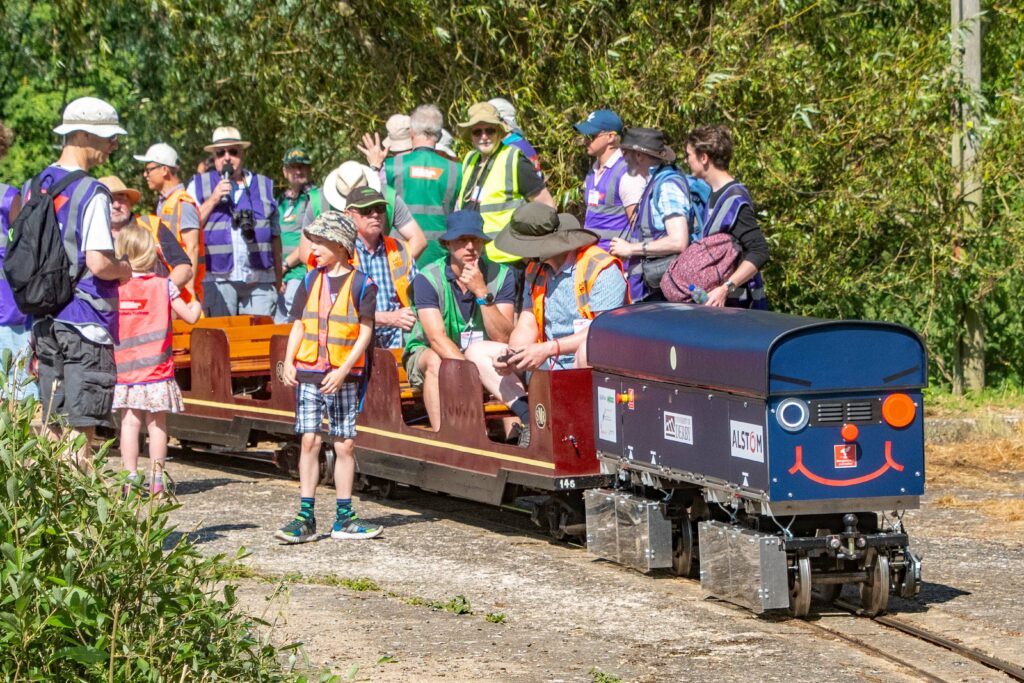
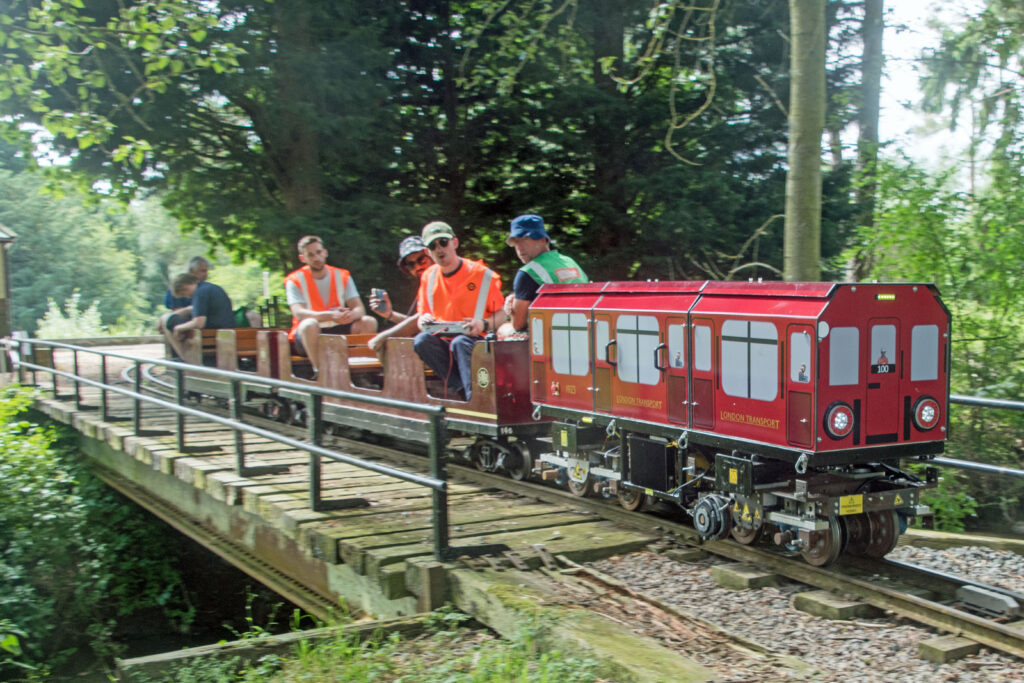
The combined Network Rail graduates and Colas apprentices team had built their locomotive at Colas’s depot in Rugby. Dan Manchee advised that although Network Rail’s graduates were encouraged to participate in the Railway Challenge, it was not part of the programme. Hence, this was an extra-curricular activity taking around three days a month throughout the year. For this year’s challenge, their locomotive included an autostop for the first time.
Transport for London’s (TfL) team was made up of graduates plus two apprentices and had mechanical, electrical, and project management sub teams. Eddiz Selay advised that the TfL locomotive had been enhanced to improve its reliability. Its testing at the Watford Miniature Railway helped refine its autostop capability. It was also commemorating the 100th anniversary of the introduction of the 1923 stock which were amongst the last tube trains with manually operated doors.
The smallest team present was a team of seven mechanical engineering students from Newcastle University. It was also the only one from an organisation new to the challenge. John Moorhouse advised that their locomotive had been delayed by Covid so was designed over a three-year period. The team’s dual gauge locomotive was first tested on the 9 ½ Lakeshore South Shields Railway. Spacers and friction locks enabled it to be converted to the 10 ¼ Stapleford gauge in a few hours.
The locomotive is intended to be run on the railway at Newcastle’s Exhibition Park and so was larger than needed for the challenge. On the Saturday, it was doubtful that the locomotive would be operational for the dynamic trials due to a control software problem and ‘fried’ brake control module.
The University of Birmingham’s entry was not as originally planned. Peter Amor advised that the manufacturer of key components for their new locomotive had gone into administration. As a result, just six weeks prior to the challenge, it was decided to use the Hydrogen Hero locomotive that was used in the 2018 challenge and had been on static display in the University. Resurrecting this locomotive required the repair of poor electrical connections and hydrogen leaks. Unfortunately, whilst running on the Saturday, the locomotive failed due to a problem with its DC/DC converter.
The results
On the Sunday, seven of the eight locomotives did their dynamic test runs. Unfortunately, Birmingham had not been able to repair their locomotive despite phoning the original designer in America. Newcastle found a workaround for their software control fault and hastily modified the brake control, though this provided only on or off braking. TfL’s locomotive failed on its way from the station for testing and was hauled back to the station by FSMR’s rescue locomotive. A control circuit had tripped when the new energy recovery status display was switched on. After this was repaired, TfL’s locomotive left the station 45 minutes late for its dynamic tests.
Although the results of the on-track tests were on a notice board, those for the non-track challenges were not. Due to this, and the judge’s assessment of any penalties incurred, the overall results announced at the prize giving ceremony were a genuine surprise. The results for the presentation, reliability, and on track challenges were as shown in the table. The top three places were very closely fought with the winner being Poznan (1648), closely followed by Derby/Alstom (1631), and FH Aachen / Reuschling (1629).
The University of Newcastle’s locomotive was the only operational locomotive on the Sunday that did not win a prize. However, producing a new locomotive that was able to enter at least some dynamic challenges was an impressive achievement worthy of note, particularly for such a small team.

The real prize for all who take part is experiencing the realities of delivering engineering projects to strict deadlines in a risk-free environment. Since 2012, a total of 77 teams have come to Stapleford for this experience which is roughly around 750 developing engineers. In this respect the IMechE’s Railway Division is providing a huge service to the industry.
Indeed, Bill Reeve noted at the award ceremony that past participants who are increasingly filling quite senior roles within the railway industry say that the Railway Challenge experience is the highlight of their training.
The Railway Division has plans for this competition to accommodate more teams, though these will only bear fruit if there are more entrants. Whilst the organising committee is considering how best to attract more teams, there perhaps needs to be greater awareness within the industry of the benefits of this event.
When reporting on the Railway Challenge, it is always a pleasure to experience the buzz at Stapleford and see the effort and enthusiasm displayed by the teams. It is also impressive to see how the FSMR, Railway Division volunteers, and IMechE staff ensure the success of this event and its smooth running.
Mention must also be made of the event sponsors whose financial contribution is essential. These were: Atkins; Angel Trains; LNER & Hitachi; Porterbrook; Railway Industry Association; RSSB; and Network Rail.

